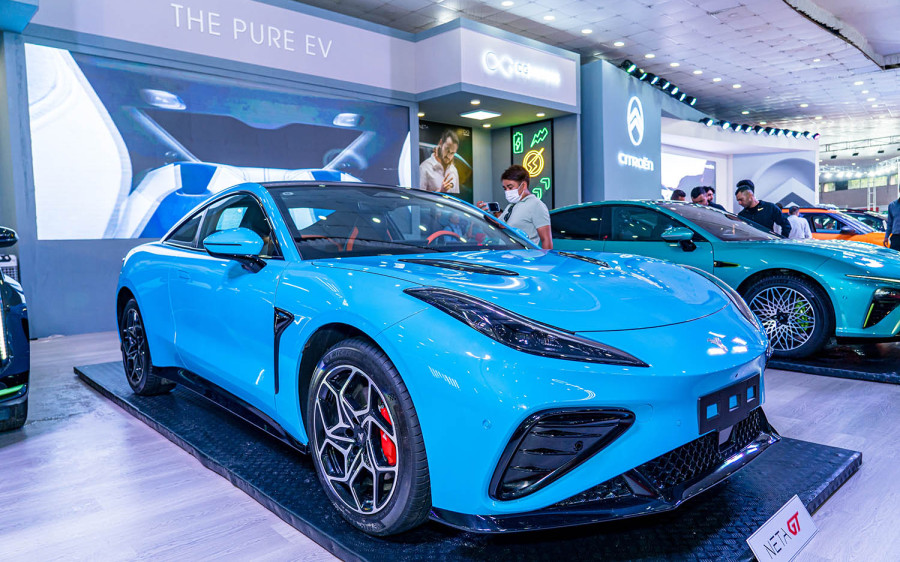Money
Nepal’s EV imports surge despite cut in bank financing
A 25.5 percent rise in electric vehicle imports in nine months, but traders warn sales may fall due to reduced financing.
Krishana Prasain
Despite the government’s decision to reduce bank financing for electric vehicles (EVs) from 90 percent to 60 percent, Nepal experienced a 25.5 percent increase in EV imports during the first nine months of the current fiscal year, until mid-April.
Automobile dealers noted that while the impact of reduced financing is starting to show in sales, it has not yet resulted in a drastic decline. According to the Department of Customs, Nepal imported 10,036 units of commercial and passenger electric vehicles during the review period, valued at Rs24.75 billion.
In contrast, the country imported 6,268 units of gasoline-powered commercial and passenger vehicles, worth Rs9.89 billion.
Dealers say the earlier provision of 90 percent bank financing was a key factor in driving the rapid adoption of EVs in the country.
Although the government raised EV import duties by 10 percent in this fiscal year’s budget, strong sales continued, largely fuelled by easy access to financing.
However, following a mid-term review of monetary policy by Nepal Rastra Bank, the maximum financing limit for EVs was lowered to 60 percent. Simultaneously, the financing limit for petrol and diesel vehicles was increased from 50 percent to 60 percent.
On Monday, the central bank made another amendment, allowing companies offering hire-purchase loans to provide up to 60 percent bank financing to financial service providers, down from the previous 90 percent.
Aviruchi Giri, marketing manager at Sipradi Trading, said that while there hasn’t been a sharp decline in EV sales yet, the reduction in financing has significantly raised the initial investment required from buyers. She cited the example of the Tiago EV, priced at Rs2.74 million.
Previously, a customer could book the vehicle with a down payment of Rs550,000. Under the new rules, buyers must now pay Rs1.1 million upfront if opting for bank financing. According to Giri, this change will likely impact demand.
Despite the broader economic slowdown, EV sales had continued to grow steadily.
Dealers stressed that a significant portion of EV buyers in Nepal depend on loans.
According to the central bank, hire-purchase loans rose by 4.7 percent to Rs5.85 billion in the first eight months of the current fiscal year, which ended in mid-March, compared to the same period a year ago.
Although EVs are more economical over time, their upfront costs remain higher than those of gasoline-powered alternatives. International developments could also influence EV pricing.
Media reports suggest that the US administration’s global tariff strategy may result in higher prices for imported parts and components used in electric vehicle (EV) manufacturing. As production costs rise, the retail price of EVs may increase, making them less accessible to consumers.
Dealers warned that the combined impact of reduced financing and rising global costs could significantly dampen EV sales in the near future. Some predict that sales could fall by as much as 50 percent. Market feedback suggests that inquiries and bookings for EVs have already declined.
Traders also expressed concern about the government's inconsistent EV policy, which they say complicates long-term planning and coordination with manufacturers.
Some international automakers had been studying the feasibility of setting up production plants in Nepal, encouraged by the country's growing EV market. However, the abrupt policy change, particularly regarding financing, reportedly discouraged them from proceeding due to increased investment risk.
Nepal's EV sector saw substantial growth last fiscal year, ending in mid-July, with a 149 percent increase in imports. During that period, the country brought in 11,701 EVs worth Rs29.48 billion.
Dealers attributed this growth to tax waivers, low-interest financing, and a broad range of available models catering to different consumer preferences. Popular models are currently priced between Rs4 million and Rs5.5 million, though higher-end options are also seeing increased demand.
Despite the rise in electric vehicle (EV) popularity, fossil fuel imports have continued to increase. Nepal imported 547,574 kilolitres of petrol worth Rs47.77 billion during the first nine months of the current fiscal year.
The quantity of petrol imports increased by 8 percent, while the value fell by 4.93 percent.
Similarly, the country imported 1.01 million kilolitres of diesel worth Rs91.26 billion. Diesel import volume rose by 2.67 percent, but its value decreased by 11.58 percent over the same period.
EV adoption carries not only economic advantages but also environmental benefits. With zero tailpipe emissions, EVs help combat air pollution—a pressing issue in urban Nepal—and contribute to the reduction of greenhouse gas emissions, aligning with the country’s climate goals. Economically, EVs reduce dependence on costly fossil fuel imports, which can positively influence Nepal’s trade balance over time.
Operating and maintenance costs of EVs are significantly lower than those of internal combustion engine vehicles, offering long-term savings to consumers. Furthermore, the expanding EV market opens new avenues for business, such as the development of charging stations and EV-specific maintenance services.
While Nepal’s EV market has shown impressive growth, it now faces uncertainty due to shifting policies and external pressures. Market analysts say that sustaining this momentum will require stable government policies, continued investment in infrastructure, and consumer confidence in the affordability and long-term benefits of electric mobility.




 23.41°C Kathmandu
23.41°C Kathmandu













.jpg&w=300&height=200)

